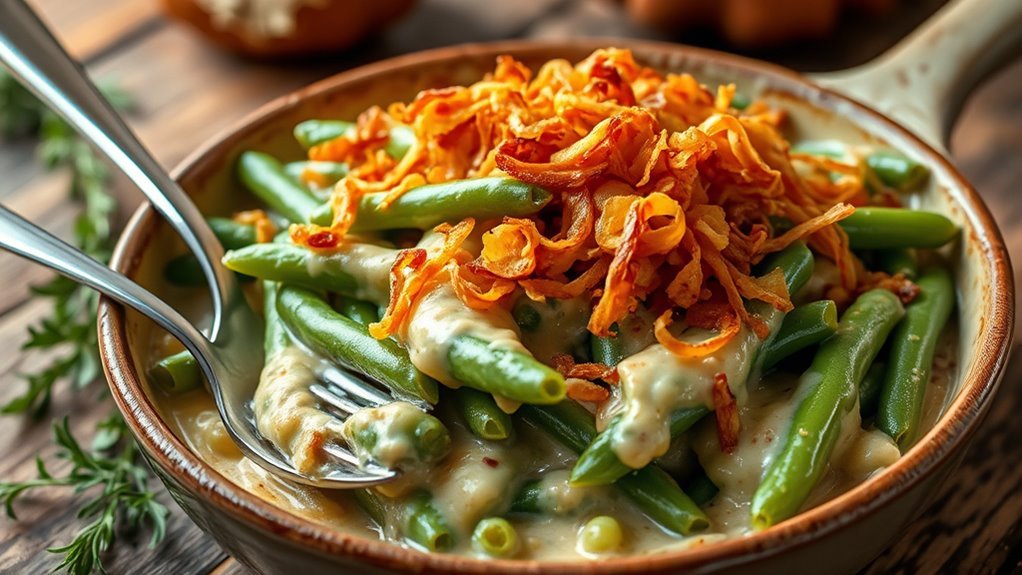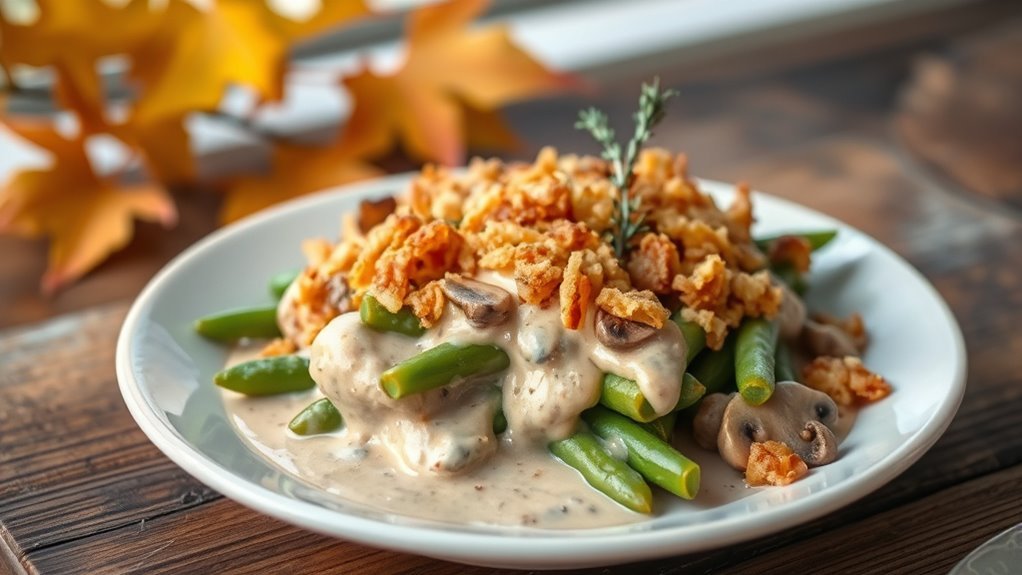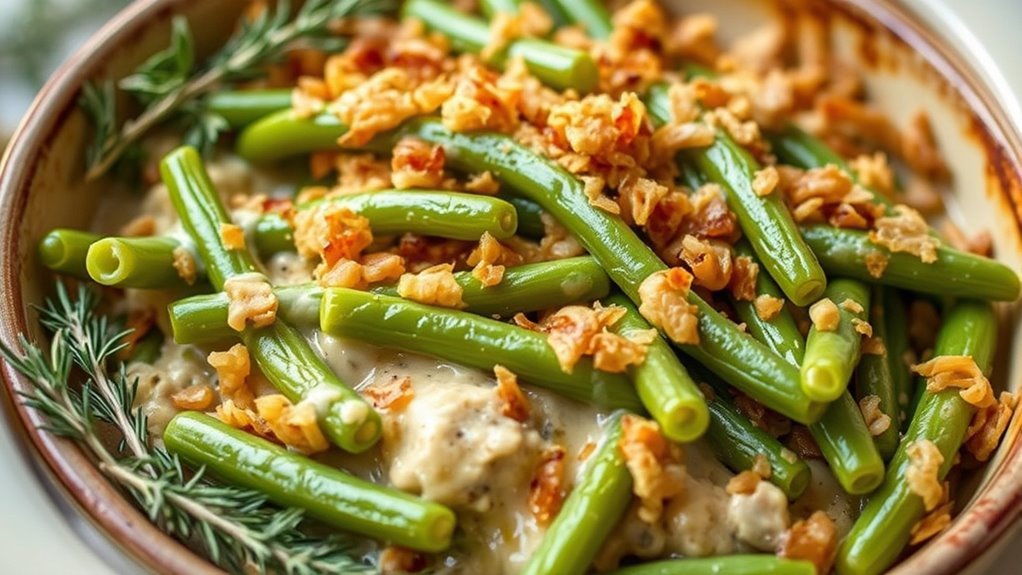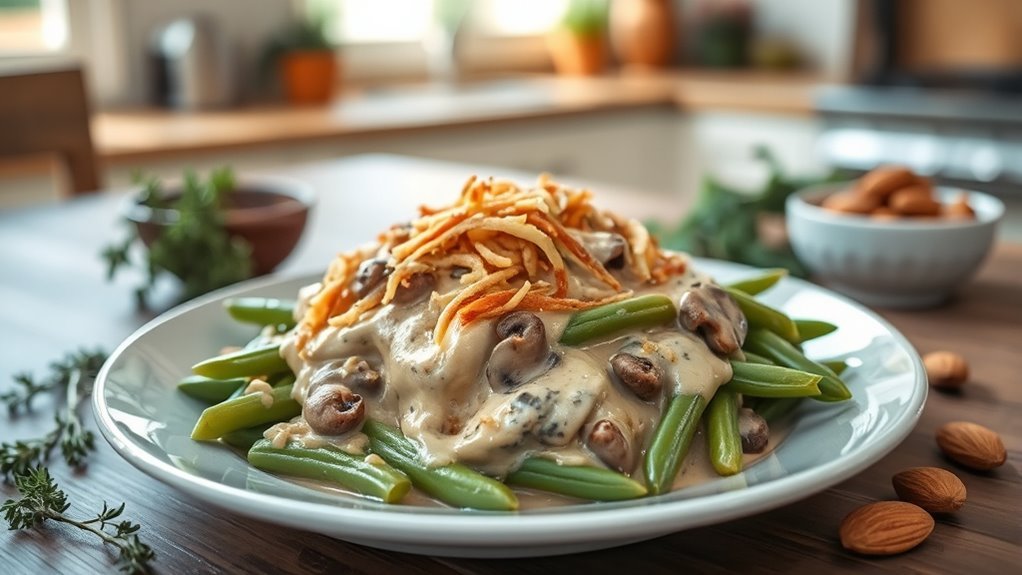Traditional green bean casserole isn’t keto-friendly due to its high carb content from ingredients like cream of mushroom soup and fried onions. However, you can easily adapt it by using alternatives like cauliflower puree and crushed pork rinds for a low-carb version. Fresh green beans and heavy cream can keep the dish rich and delicious without the carbs. If you’re curious about more substitutions and flavor enhancements, there’s plenty more to explore.
Traditional Ingredients of Green Bean Casserole

When you think about traditional green bean casserole, you might picture the classic combination of ingredients that make this dish a holiday favorite. The traditional preparation typically involves green beans, cream of mushroom soup, and milk, creating a rich and creamy base. You’ll often find crispy fried onions as classic toppings, adding a delightful crunch that contrasts with the smoothness of the casserole. Some variations include adding cheese or even spices to enhance the flavor. This dish embodies comfort food, making it a staple at gatherings. However, understanding these ingredients helps you appreciate its classic appeal while considering any dietary preferences or restrictions you may have. Embracing this knowledge allows you to enjoy the dish fully during festive occasions.
Evaluating Carb Content

When you look at traditional green bean casserole, it’s important to identify the main sources of carbohydrates, like the cream of mushroom soup and fried onions. You might be surprised to find that these ingredients can greatly increase the dish’s carb content, making it less keto-friendly. Fortunately, there are keto-friendly alternatives available, allowing you to enjoy a lower-carb version without sacrificing flavor.
Carb Sources in Casserole
Although green bean casserole is a beloved dish at many gatherings, it’s essential to evaluate its carbohydrate sources to determine if it aligns with a keto-friendly diet. Different casserole types can vary greatly in carb content. Here are some common carb sources found in traditional green bean casseroles:
- Green Beans: While relatively low in carbs, they still contribute to the total.
- Cream of Mushroom Soup: Often contains flour or starch, increasing the carb count.
- Fried Onions: Typically breaded, they can add substantial carbs.
- Other Vegetables: Ingredients like corn or peas, if included, can elevate the carbohydrate level.
To make a more informed decision, be aware that baked beans can have higher carbohydrates, which may affect your overall carb intake on a keto diet.
Keto-Friendly Alternatives Available
If you want to enjoy green bean casserole while staying true to a keto diet, there are several alternatives you can consider that markedly reduce the carb content. Instead of traditional cream soups, try using homemade cauliflower puree or a blend of cream cheese and chicken broth to achieve that creamy texture without the carbs. For the crispy topping, crushed pork rinds or almond flour mixed with cheese can replace fried onions. You can also add mushrooms for extra flavor while keeping carbs low. Pair your casserole with keto desserts or low carb snacks to satisfy your cravings. These alternatives allow you to enjoy the classic flavors without compromising your dietary goals, giving you the freedom to indulge guilt-free. Additionally, understanding macronutrient ratios can help you balance your meal for optimal success on the keto diet.
Keto-Friendly Substitutions

To create a keto-friendly green bean casserole, you’ll need to make some thoughtful substitutions that maintain flavor while reducing carbohydrates. Here are four key swaps to take into account:
- Keto Dairy: Use heavy cream or cream cheese instead of traditional soups to keep it rich without the carbs.
- Green Beans: Opt for fresh or frozen green beans rather than canned ones, which can contain added sugars.
- Low Carb Toppings: Replace crispy fried onions with crushed pork rinds or almond flour mixed with spices for a crunchy texture.
- Bouillon: Enhance flavor with low-sodium vegetable or chicken bouillon instead of high-carb sauces.
These substitutions help you enjoy a delicious, satisfying casserole that aligns with your keto lifestyle while keeping your carbohydrate intake in check.
Making a Low-Carb Version
When you’re looking to make a low-carb version of green bean casserole, ingredient substitutions are key. For instance, using almond flour instead of traditional breadcrumbs can considerably reduce carbs while still adding texture. Additionally, adjusting cooking techniques, like sautéing fresh green beans rather than using canned, can enhance flavor and nutrition. Incorporating low-carb vegetables such as Brussels sprouts can further boost the dish’s nutritional profile while keeping it keto-friendly.
Ingredient Substitutions
Although traditional green bean casserole is beloved for its creamy texture and savory flavors, you can easily make a low-carb version by swapping out a few key ingredients. This guarantees a satisfying dish without compromising your dietary goals. Here are some ingredient substitutions to take into account:
- Green Beans: Use fresh or frozen green beans instead of canned for better texture and lower carbs.
- Cream of Mushroom Soup: Replace it with a homemade version using heavy cream and sautéed mushrooms for a rich flavor.
- Bread Crumbs: Opt for crushed pork rinds or almond flour as a crunchy topping.
- Onion: Substitute with sautéed shallots for a milder taste with fewer carbs.
Additionally, incorporating Brussels Sprouts into your casserole can enhance the nutritional profile while keeping it low in net carbs.
Cooking Techniques
Making a low-carb green bean casserole isn’t just about ingredient substitutions; it’s also about using the right cooking techniques to enhance flavor and maintain texture. Start by blanching your green beans in boiling water for a few minutes, then plunge them into ice water. This preparation technique keeps them vibrant and crisp. For the creamy base, sauté mushrooms in butter, allowing their moisture to evaporate, which intensifies their flavor. Instead of traditional flour, consider using almond flour or coconut flour as a thickening agent. When it comes to baking, opt for a higher temperature to achieve a golden crust without overcooking the beans. By mastering these cooking methods, you’ll create a delicious, satisfying casserole that aligns with your keto lifestyle.
Tips for Enhancing Flavor
To elevate the flavor of your keto-friendly green bean casserole, consider incorporating a variety of seasonings and ingredients that enhance its natural taste without adding unnecessary carbs. Here are some tips to boost flavor:
- Garlic Powder: Adds depth and aroma; it’s a must for any savory dish.
- Onion Powder: Complements the green beans and provides a subtle sweetness.
- Spice Blends: Try Italian seasoning or Cajun spice blends to introduce complexity.
- Nutritional Yeast: This flavor enhancer mimics a cheesy taste without the carbs.
Additionally, incorporating green onions can provide a fresh and zesty kick to your casserole. Experimenting with these elements not only enriches your dish but also keeps it keto-friendly. You’ll find that a little creativity can lead to delightful, satisfying meals that honor your dietary choices.
Serving Suggestions and Pairings
When hosting a gathering or enjoying a family meal, serving your keto-friendly green bean casserole alongside complementary dishes can enhance the overall dining experience. Consider pairing your casserole with a juicy grilled chicken or a savory pork roast for a protein boost. A fresh salad with low-carb dressing can add a revitalizing crunch. Additionally, incorporating low-carb leafy greens into your meal can further enrich the nutrient profile of your dining experience.
Here are some great casserole pairings and serving suggestions:
| Casserole Pairings | Serving Suggestions |
|---|---|
| Grilled Lemon Chicken | Side of Cauliflower Rice |
| Beef Tenderloin | Garlic Roasted Asparagus |
| Baked Salmon | Creamy Zucchini Noodles |
These combinations not only satisfy your taste buds but also keep your meal within keto guidelines, ensuring you enjoy every bite guilt-free.
Frequently Asked Questions
Can I Use Frozen Green Beans Instead of Fresh?
Absolutely, you can use frozen green beans instead of fresh! In fact, studies show that frozen vegetables can retain up to 90% of their nutrients, making them a convenient choice. While fresh green beans typically take about 5-7 minutes to cook, frozen ones might need an extra minute or two. This means you can save time in the kitchen without sacrificing your health. Enjoy the freedom of quick, nutritious meals with either option!
How Can I Make It Vegetarian While Keeping It Keto?
You can make your green bean casserole vegetarian and keto-friendly by using low-carb alternatives like cauliflower for a creamy base. Incorporate vegetarian protein sources, such as tempeh or tofu, to boost the dish’s nutritional value. Instead of traditional cream, consider unsweetened almond milk or coconut cream for richness. Use gluten-free breadcrumbs made from crushed nuts or seeds for topping, ensuring the casserole remains flavorful while sticking to your dietary preferences. Enjoy your creation!
Is There a Dairy-Free Option for the Casserole?
Yes, there are dairy-free options for your casserole! You can use dairy alternatives like coconut milk or nut milk, such as almond or cashew milk, to create a creamy texture without dairy. Just make sure to choose unsweetened versions to keep your dish keto-friendly. Incorporating nutritional yeast can also add a cheesy flavor without using any dairy. This way, you can enjoy a rich and satisfying green bean casserole that suits your dietary needs!
Can I Prepare It Ahead of Time and Freeze It?
Absolutely, you can prepare it ahead of time and freeze it! Think of it as tucking a cozy blanket around your meal prep. For freezing tips, let it cool completely before transferring it to an airtight container. You might want to layer parchment paper between servings for easy access later. When you’re ready to enjoy it, thaw overnight in the fridge and reheat gently to maintain that delicious comfort. Enjoy your freedom in meal planning!
What Is the Best Way to Reheat Leftovers?
The best way to reheat leftovers is by using either the microwave or the oven. For microwave reheating, place your portion in a microwave-safe dish, cover it loosely, and heat in short intervals, stirring occasionally to guarantee even warming. If you prefer oven reheating, preheat to 350°F, place the casserole in a covered dish, and heat for about 20-30 minutes. This method helps maintain the texture and flavor of your dish. Enjoy!


